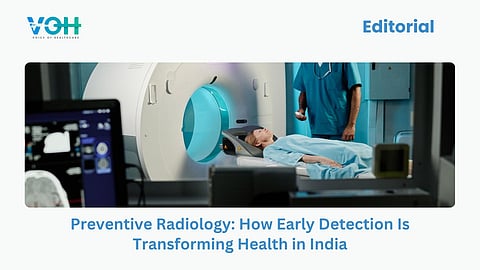

Radiology was traditionally considered a diagnostic tool—used only when symptoms appeared or a disease was already suspected. But India is now moving toward a model of preventive radiology, where imaging is used to identify silent diseases long before symptoms start. With newer technologies like low-dose CT (LDCT), faster MRI systems, and AI-based reporting platforms, early detection has become safer, faster, and more accessible.
This shift is particularly important in India because many chronic conditions remain asymptomatic for years before they cause noticeable illness. Detecting these early can help reduce complications, improve outcomes, and lower long-term healthcare costs
Cardiovascular disease is becoming more common at younger ages among Indian and South Asian populations. Scientific data consistently shows that South Asians experience heart attacks nearly a decade earlier than Western populations, and pooled clinical data indicates that about 25% of heart attacks occur before the age of 40 in South Asians, highlighting the need for early detection.
Similarly, lung cancer in India is often diagnosed late. According to the ICMR–NCDIR National Cancer Registry Programme, 44.8% of patients present with distant metastasis and 35.3% with loco-regional spread, meaning nearly 80% of cases are detected at an advanced stage, when curative treatment becomes more difficult.
Another silent epidemic is fatty liver disease. A 2022 meta-analysis of 29 Indian studies found a 38.6% prevalence of NAFLD among Indian adults, reflecting the high metabolic disease burden in the country.
Osteoporosis also remains largely undiagnosed until fractures occur. Indian epidemiological estimates show that over 60 million Indians have osteoporosis or low bone mass, emphasizing the need for early bone-health assessment.
These conditions progress silently for years, and by the time symptoms appear, the disease is often advanced—making preventive imaging especially valuable.
One of the most important breakthroughs in preventive radiology is the development of Low-Dose CT (LDCT). LDCT uses 60–90% less radiation than traditional CT scans, making it suitable for screening and periodic assessment.
LDCT is increasingly being used in India for early lung-cancer detection, coronary calcium scoring, fatty-liver evaluation, and bone-health assessment. Because a single LDCT scan can provide insights into the lungs, heart-risk, liver-fat, and bone density, it has become a valuable tool in modern preventive health check-ups.
LDCT radiation exposure is roughly equivalent to 3–4 months of natural background radiation, which is considered very safe when medically indicated.
Another advancement in preventive radiology is "opportunistic screening", where radiologists extract additional preventive data from scans originally done for other reasons. A routine CT abdomen can reveal early fatty liver or visceral fat; a chest CT done for infection can show early coronary calcium; and a lumbar spine CT/MRI can reveal bone loss suggestive of early osteoporosis.
This approach is now being adopted by many large hospitals and diagnostic chains in India.
Artificial intelligence is rapidly transforming radiology workflows across major Indian cities. AI tools can detect tiny lung nodules, quantify liver fat, measure coronary calcium, and assess bone density with high precision. These systems do not replace radiologists but enhance accuracy, reduce reporting variability, and speed up interpretation—crucial in a country with a limited number of radiologists.
Modern CT machines can complete chest or body imaging in under 10 seconds, making them comfortable for elderly or anxious patients. MRI systems are now quieter, faster, and offer reduced scan times. Abbreviated MRI protocols, especially for breast and liver screening, reduce scanning time and cost without compromising quality.
Mobile LDCT units are also being piloted in India to bring preventive screening to high-risk areas such as industrial zones and high-pollution districts.
Preventive radiology will increasingly help detect disease before symptoms appear, predict long-term risk, and personalize health strategies. India is moving towards integrating preventive scans into annual health check-ups, expanding imaging access in tier-2 and tier-3 regions, and using portable devices with cloud-based reporting.
With rising metabolic disease, high pollution exposure, and greater awareness post-COVID, preventive imaging is becoming a key pillar of Indian healthcare.
Modern imaging—especially LDCT, MRI, and AI-enabled scans—offers a powerful opportunity to identify heart disease, lung nodules, fatty liver, and bone loss long before symptoms appear. In a country where many diseases are diagnosed late, preventive radiology can dramatically improve long-term health outcomes.